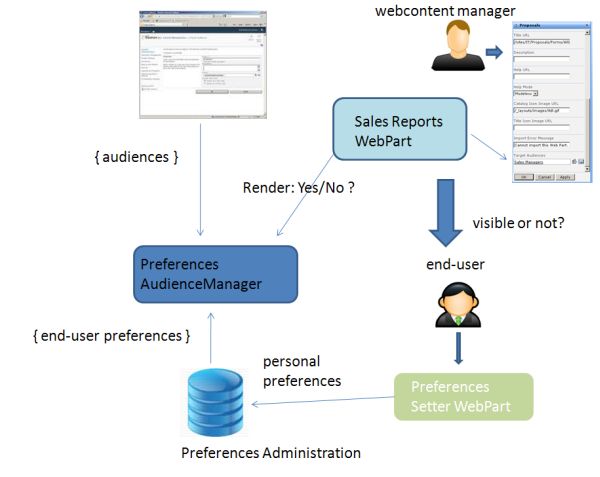In a SharePoint project, one of the requirements is to enable the end-user to set preferences, which are then immediately be applied in the portal. One of the settable preferences is the (non)interest in subjects/functions: if interested, webparts will be visible; if non-interest specified, the webpart will be invisible. Well, this kinda sounds like SharePoint audiences. As this is out-of-the-box SharePoint functionality, it is applicable for both our own custom webparts as well as standard and third-party webparts. The only problem is the sub-requirement to have the preferences immediately applied in the portal. Standard SharePoint audiencing requires to compile the Audience before it takes effect, which either occurs on scheduled basis or on request. But never immediately.
The solution for this is to utilize a custom PreferencesAudienceManager, with functionality to on-the-fly derive Audience membership on basis of the selected settings.
System architecture

PreferencesAudienceManager code-extract
public class PreferencesAudienceManager : IRuntimeFilter2
{
...
public bool CheckRuntimeRender(string IsIncludedFilter)
{
bool render = false;
if (SPContext.Current != null && SPContext.Current.Web.CurrentUser != null)
{
// Priority to OOTB SharePoint Audiencing.
render = AudienceManager.IsCurrentUserInAudienceOf(IsIncludedFilter, true);
if (!render)
{
string[] globalAudienceIDs = null;
string[] dlDistinguishedNames = null;
string[] sharePointGroupNames = null;
int num = AudienceManager.GetAudienceIDsFromText(IsIncludedFilter, out globalAudienceIDs, out dlDistinguishedNames, out sharePointGroupNames);
if (num > 0 && globalAudienceIDs != null && globalAudienceIDs.Length > 0)
{
string userIdent = PersonalizationUtils.GetCurrentUserIdentifier;
UserPreferences userPreferences = PreferencesRepository.ReadUserPreferences(userIdent);
SPServiceContext context = SPServiceContext.GetContext(SPContext.Current.Site);
AudienceManager am = new AudienceManager(context);
foreach (string audienceId in globalAudienceIDs)
{
Guid g = new Guid(audienceId);
Audience a = am.Audiences[g];
string preferenceAudienceName = a.AudienceName;
UserPreferences preferenceAudience = (UserPreferences)Enum.Parse(typeof(UserPreferences), preferenceAudienceName );
if ((preferenceAudience & userPreferences) == preferenceAudience)
{
render = true;
break;
}
}
}
}
}
return render;
}
There is on caveat you need to be aware of; the ability to even use Audiences functionality, requires that the User Profile Service Application is installed in the farm. Microsoft namely placed the Audience functionality within the context of User Profile; even though you can thus apply Audiencing without dependency of User Profile values.


Great post. Did you notice any substantial performance impact using this? Would you also be able to share what the UserPreferences and PersonalizationUtils classes look like? Thanks.
ReplyDeleteWe don't experience a noticeable performance impact. This is mostly due relying on the strengths of SQL platform + stored procedures for storing the user preferences.
ReplyDelete